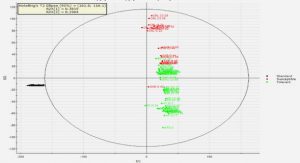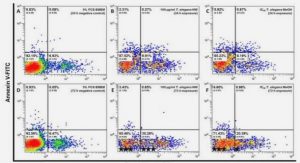Get Complete Project Material File(s) Now! »
Addition of titanocene dichloride to L2-04
Lithiation of L2-04 proceeded in a high yield and on addition of titanocene dichloride, the colour changed from red to orange-brown. From the silica gel column chlorobis( cyciopentadienyl)(thianthren-l-yl)titanium(IV), [TiCp2(Thr)CI] (2-09) was collected followed by a yellow fraction bis( cyciopentadienyl)bis(thianthren-l-yl)titanium(IV), [TiCp2(Thrh] (2 lOa), which was too unstable to purifY. Complex 2-09 readily converted into a second yellow product, (~-oxo)bis[bis( cyciopentadienyl)(thianthren-l-yl)titanium(IV)] [(!1-0){TiCp2(Thr) h] (2-10). Due to the instability of 2-09 in solution, the only way to characterize the complex was through measuring the lH NMR spectrum as soon as possible. Attempts to obtain a l3C NMR spectrum failed, as the complex already started to decompose to 2-10 during measurement. In comparison with 2-05, complex 2-09 is far less stable, indicating that the L2-04 ligand has a stronger activation effect on the remaining chloro ligand, than was the case with the L2-03 ligand.
The yellow fraction in this case originated from 2-09. The fact that 2-10a was too unstable to isolate is ascribed to steric constraints of the two ring ligands. Comparing stabilities one could conclude that 2-05 > 2-09 and 2-06a > 2-10a. Although 2-10 and 2-06 originate from different precursors, the conversion in both cases is brought about by the presence of water on the column material. The desired complex 2-09 has a highly activated chloro ligand, which in the presence of traces of water converts into the corresponding hydroxo complex. In a subsequent reaction the hydroxo complex forms the dinuclear complex 2-10, by the elimination of water between two intermediate hydroxo complexes or the elimination of hydrochloric acid between complex 2-09 and a hydroxo intermediate complex (Scheme 2.4).
IH NMR spectroscopy
When comparing the chemical shifts of L3-03, with L2-03 (Chapter 2), it is clear that the addition of the sulfur atom did not, with the exception of H2, influence the chemical shifts much. The same was observed for L3-04 compared to L2-04. The chemical shifts of the protons of the ring without the thiol group are roughly the same as the corresponding resonances for the protons of L2-06 or L2-01, but due to their overlapping signals the specific chemical shifts could not be assigned for H6-H9. The ring with the thiolate sulfur as substituent has a downfield shift of 0.34ppm (1.3-03) and 0.24ppm (L3-04) for H2 compared to L2-03 and L2-04, respectively, whereas the resonances ofH3 and H4 are little affected. The proton closest to the substituent is shifted downfield because of the electron withdrawing effect of the sulfur atom. In the spectrum of L3-03b the presence of the butyl group is seen in resonances at ppm-values of2.90, 1.44, and 0.89. The triplet at 2.9ppm is indicative of protons on a carbon attached to a sulfur atom and adjacent to a methylene carbon. This observation supports L3-03b being a thioether rather than a butyl substituent on the thiophenol ring of the dioxin molecule.
13C NMR spectroscopy
In L3-03, L3-03b and 1.3-04 the chemical shift of Cl is observed downfield due to the electron withdrawing effect of the thiol/thioether substituent. The other carbons are little affected and have about the same chemical shifts compared to the corresponding carbons in the unsubstituted heteroaromatic compounds. The carbons C2 and C3 are downfield and this correlates with the results from the IH NMR spectrum. The resonances of the ipso carbons of Cl(C4) (ca 140ppm) of the thiolato complexes are shifted downfield but not as far as was observed for the complexes where this carbon was directly bonded to the titanium centre (ca 180 ppm). The values fall between those of the uncoordinated thiols and the titanium-C(heteroarene) complexes. This observation is supported by the ‘H NMR data. The neighbouring carbons, C2 (C3) and C12 (CII), also display resonances that represent downfield shifts, but much less than C 1.
Resonances of carbons, C 11 and C 12, are further downfield because of the effects of the neighbouring oxygen atoms. The rest of the chemical shifts are quite similar to those of the uncoordinated heteroaromatic molecules. The Cp signal is upfield (about 3 – 8 ppm) due to increased electron density on the metal fragment, when compared to titanocene dichloride. In 3-12 the Cp signals appear as two single peaks in a ratio of 3: 1. This ratio is repeated for the rest of the spectrum and can be ascribed to two different isomers in solution. The HETCOR spectra of L3-03 and 3-04 were used to assign and correlate the specific proton resonances to the corresponding carbons resonances. Again it was impossible to assign the protons in the unsubstituted ring ofL3-03.
Synthesis
Schemes 4.1 and 4.2 represent the planned syntheses of complexes where a heteroatom is used to replace a chloro ligand in the coordination sphere oftitanium. Titanium has a strong affinity for sulfur and oxygen ligands and the introduction of thiolate and oxolate donor atoms were considered. The bridging ligand was to be constructed by either adding one or two equivalents of epoxide to ethylene diamine. When two equivalents of epoxide were added, two titanocene chloride fragments are found at the ends of the bridging ligand with the possibility to afterwards introduce a platinum fragment. For one equivalent epoxide the result would lead to a binuclear Ti-Pt complex. To enable the addition of only one equivalent of epoxide methyl ethylene diamine was chosen as starting substrate as the methyl group would effectively block one side of the molecule. The same basic procedure was followed for thiiran, as shown in Scheme 4.1 for epoxides, but in this case the bridge was build by adding two equivalents of thiiran to N,N’-dimethyl ethylene diamine L4 03 and reacting at high temperature and pressure (Scheme 4.2). The product was purified by filtration and distillation to yield a colourless oil [CSH20N2S] U-04.
The addition of this new ligand to two equivalents of titanocene caused a colour change from red to orange-red. The product was extracted with dichloromethane and addition of hexane precipitated [{Il-CsHUIN2S2}ThCp4ChJ 4-03 as a redorange product. The binuclear complex was characterized by IH NMR spectroscopy. The addition of one equivalent of thiiran to L4-02 and reaction at high pressure and temperature yielded an oily substance that was purified by filtration and distillation. The resulting colourless oil was identified as [CSH14N2S] L4-0S. Reaction of this substrate with titanocene dichloride changed the colour of the mixture from red to red-orange. Extraction with dichloromethaneand precipitation with hexane yielded an orange product [TiCp2(SC6HJ5N2)CI] 4-04. Subsequent reactions of 4-03 and 4-04 with K2[PtCI4] again did not afford the desired bi- and trinuclear complexes of platinum and titanium.
Table of contents :
- Summary
- Abbreviations
- List of compounds
- Chapter 1 : Antitumor properties of cisplatin and titanium(lV) complexes
- 1.1 Introduction
- 1.2 Cisplatin
- 1.3 Metallocene compounds
- 1.3.1 Titanocene dichloride
- 1.3.2 Budotitane
- 1.4 Modes of Action
- 1.4.1 Covalent bond formation of titanium(lV)
- 1.4.2 Intercalation
- 1.5 Aim of Study
- 1.6 Construction of thesis
- Chapter 2 : Titanocene derivatives with a heteroaromatic ligand containing
- a direct metal-carbon a-bond
- 2.1 Introduction
- 2.2 Synthesis
- 2.3 Characterization
- • Mass spectrometry
- • 1H NMR and 13C NMR spectroscopy
- • X-ray crystallography
- 2.4 Conclusions
- Chapter 3 : Titanocene derivatives with heteroaromatic thiolate ligands
- 3.1 Introduction
- 3.2 Synthesis
- 3.3 Characterization
- • Mass spectrometry
- • 1H NMR and 13C NMR spectroscopy
- • X-ray crystallography
- 3.4 Conclusions
- Chapter 4 : Bi- and trinuclear complexes of titanium(l¥) and platinum(11)
- 4.1 Introduction
- 4.2 Synthesis
- 4.3 Characterization
- • Mass spectrometry
- • 1H NMR and 13C NMR spectroscopy
- 4.4 Conclusions
- Chapter 5: Antitumor properties, DNA interaction and ligand substitutions
- 5.1 Introduction
- 5.2 Antitumor activity
- 5.2.1 Conclusions
- 5.3 Structural features vs. antitumor activities
- 5.3.1 Conclusions
- 5.4 Ligand substitution in aqueous medium
- 5.4.1 Conclusions
- 5.5 Intercalation studies
- 5.5.1 Conclusions
- 5.6 Summary of test results and DNA interaction
- Chapter 6: Experimental
- 6.1 General
- 6.2 Lithiation and synthesis of heteroaromatic compounds
- 6.3 Synthesis of titanocene derivatives
- 6.4 Synthesis of bi- and trinuclear complexes
- 6.5 In vitro tests
- 6.6 Studies related to the antitumor activities of the complexes
- 6.7 Crystal structure determinations
- Appendix A
- Appendix B
- Appendix C
- Appendix D
- Appendix E
- Appendix F
GET THE COMPLETE PROJECT
Structure-activity relationships of titanocene complexes with antitumor properties






